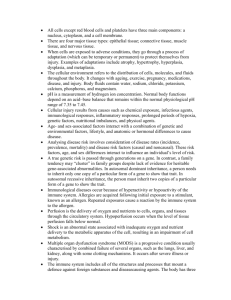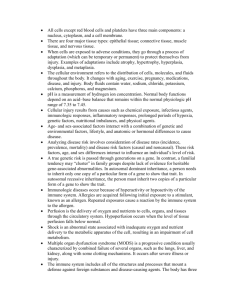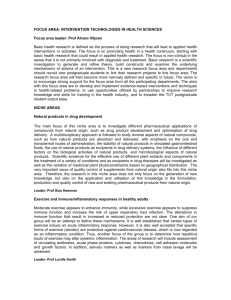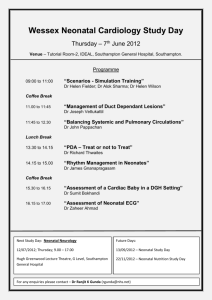Word File - University of Georgia College of Veterinary Medicine
advertisement
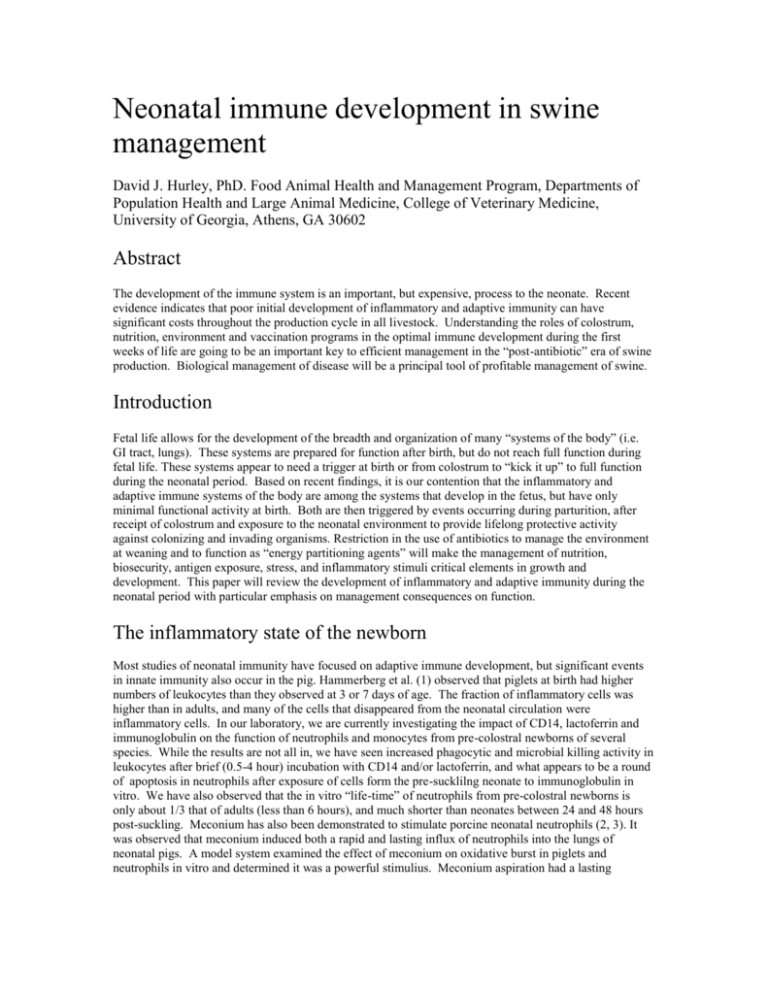
Neonatal immune development in swine management David J. Hurley, PhD. Food Animal Health and Management Program, Departments of Population Health and Large Animal Medicine, College of Veterinary Medicine, University of Georgia, Athens, GA 30602 Abstract The development of the immune system is an important, but expensive, process to the neonate. Recent evidence indicates that poor initial development of inflammatory and adaptive immunity can have significant costs throughout the production cycle in all livestock. Understanding the roles of colostrum, nutrition, environment and vaccination programs in the optimal immune development during the first weeks of life are going to be an important key to efficient management in the “post-antibiotic” era of swine production. Biological management of disease will be a principal tool of profitable management of swine. Introduction Fetal life allows for the development of the breadth and organization of many “systems of the body” (i.e. GI tract, lungs). These systems are prepared for function after birth, but do not reach full function during fetal life. These systems appear to need a trigger at birth or from colostrum to “kick it up” to full function during the neonatal period. Based on recent findings, it is our contention that the inflammatory and adaptive immune systems of the body are among the systems that develop in the fetus, but have only minimal functional activity at birth. Both are then triggered by events occurring during parturition, after receipt of colostrum and exposure to the neonatal environment to provide lifelong protective activity against colonizing and invading organisms. Restriction in the use of antibiotics to manage the environment at weaning and to function as “energy partitioning agents” will make the management of nutrition, biosecurity, antigen exposure, stress, and inflammatory stimuli critical elements in growth and development. This paper will review the development of inflammatory and adaptive immunity during the neonatal period with particular emphasis on management consequences on function. The inflammatory state of the newborn Most studies of neonatal immunity have focused on adaptive immune development, but significant events in innate immunity also occur in the pig. Hammerberg et al. (1) observed that piglets at birth had higher numbers of leukocytes than they observed at 3 or 7 days of age. The fraction of inflammatory cells was higher than in adults, and many of the cells that disappeared from the neonatal circulation were inflammatory cells. In our laboratory, we are currently investigating the impact of CD14, lactoferrin and immunoglobulin on the function of neutrophils and monocytes from pre-colostral newborns of several species. While the results are not all in, we have seen increased phagocytic and microbial killing activity in leukocytes after brief (0.5-4 hour) incubation with CD14 and/or lactoferrin, and what appears to be a round of apoptosis in neutrophils after exposure of cells form the pre-sucklilng neonate to immunoglobulin in vitro. We have also observed that the in vitro “life-time” of neutrophils from pre-colostral newborns is only about 1/3 that of adults (less than 6 hours), and much shorter than neonates between 24 and 48 hours post-suckling. Meconium has also been demonstrated to stimulate porcine neonatal neutrophils (2, 3). It was observed that meconium induced both a rapid and lasting influx of neutrophils into the lungs of neonatal pigs. A model system examined the effect of meconium on oxidative burst in piglets and neutrophils in vitro and determined it was a powerful stimulius. Meconium aspiration had a lasting inflammatory effect, with many pigs developing and ARDS-like syndrome over a period of 2 weeks. It appears that ingestion of meconium may also stimulate inflammatory activation in the neonate. The SWC3 antibody (74-22-15) has been used to monitor granulocytes, monocytes and macrophages in the tissues of developing swine (4). It was observed in normally reared piglets that the highest fraction of SWC3 positive cells was seen in peripheral blood and mucosal lymphoid tissues at day 1 of age. The fraction of inflammatory cells declined in both blood and the mucosal tissues with age, and dropped dramatically following weaning. MHC class II antigens, which are expressed on all activated mononuclear cells in swine, were observed to make up a much smaller fraction of circulating cells than in the adult or in the animals as they mature. MHC class II is an important “player” in the function of monocyte derived cells, having a role in bridging the transition from innate to adaptive response to antigens in the body. Further, we have observed that calves deprived of colostrum or maternal cells from colostrum require about a week to have a significant increase in the fraction of MHC class II positive circulating cells, but calves receiving whole maternal colostrum containing maternal cells show a large increase in the fraction of MHC class II positive cells in circulation within 24 to 48 hours. Adaptive immunity in the neonate There have been many studies of the pattern of adaptive immunity in the neonatal pig (1,4, 5 [review], 6). At birth, the distribution of CD4 and CD8 subpopulations in peripheral blood looks like any other mammal, with a CD4 to CD8 ratio between 1.5 and 3.0 (1). In addition, the fraction of CD4/CD8 double positive cells is very low relative to the adult (7). Double positive T cells increase in the circulation with environmental exposure to antigen, particularly viral antigens (7). A similar pattern was observed in the mucosal tissues in neonatal pigs with respect to the fraction of CD4 and CD8 positive cells. Gamma-delta T cell numbers in the circulation represent between 20 and 30 % of the total circulating cells at birth (4,5). This number declines to adult levels (10-20%) over the period of about a month. The number of circulating lymphocytes and their functional activity declines within a few days of birth, and does not approach adult levels until the piglet is 14-21 days old (1). The number of B cells in circulation at birth is lower than generally seen in the adult (1). B cell numbers increase rapidly in the Peyer patches in the ileum (peaking about 4 days of age), and following in the circulation and lymph nodes.(4,8). B-cell function is also reduced at birth and does not approach adult levels for several weeks (1, 9). There is general agreement that the function of the adaptive immune components are greatly damped at birth and do not function at adult levels. The reasons for this may be complex. It has been proposed that the density of dendritic cells is limiting in the neonate and that results in an easily over stimulated immune system with high dose antigen presented by less effective antigen presenting cells (primarily B cells) (10). In any case, the adaptive immune response must have a series of triggers, enough time and repeated antigen stimulation to develop properly. My experience with gnotobiotic neonatal piglets indicates there is a marked retardation in the development of both the inflammatory and adaptive immune functional development of these piglets raised in an essentially sterile environment (11). Neonatal piglets also show an IL-6 bias to T and B cells stimulation with plant derived mitogens during the first 14 days of life, but switched to a more adult like production of IL-2 by 3 weeks of age. (12). Nutritional and environmental factors Development of the immune system is an expensive process. Inflammatory function and the network of secondary lymphoid tissue that are required to provide life long protection from colonizing or invading organisms is dependent on good nutrition. Good quality colostrum is an essential component in the protection of the neonate and appears to be a major component in seeding the development of inflammatory and adaptive function in the neonate. Caloric or protein malnutrition has been shown to inhibit immune development and immune responses. In swine, reduction in both calories and protein in the diet was shown to make rotavirus infection in piglets more severe (13). The most pronounced changes in this model were related to inflammatory function, but adaptive immunity and its development were also retarded by malnutrition. The types and level of fats in the neonatal diet are also important in immune development. In attempts to provide altered fat profiles in pork have lead to changes in the amount and type of unsaturated fats in the diets of neonatal swine (14). The type and level of specific fats in the diet have a significant impact on the development and function of the immune system. Use of 3-omega polyunsaturated fatty acids in the diet has an impact on the production of prostaglandins and other fatty mediators of inflammation and leukotriene mediators of lymphocyte function. The fatty acid makeup of neonatal diets has been shown to have a significant influence on factors important to control of both gastrointestinal and respiratory infections in young pigs (15, 16). The composition of fatty acids in colostrum and milk can be altered by supplementation of the maternal diet, and the desired effects on inflammatory and adaptive immunity observed (17). Further, the impact of omega-3 polyunsaturated fatty acids has even been demonstrated in neonatal piglets kept in a germ-free environment (18). Compared to unsupplemented piglets, the omega-3 fed piglets had increased numbers of circulating T and B cells, and lower circulating levels of fatty mediators of inflammation. The neonatal environment has a significant impact on the immune development of the piglet. Circovirus and/or PRRS in the herd can have a significant impact on adaptive immune responses (19, 20). Circovirus in piglets was associated with a reduction in CD8+ and CD4+CD8+ cells, most often associated with antiviral memory (7). Further, even vaccination against circovirus type 2 may induce significant immune suppression and dysfunction of the inflammatory response, particularly in sows. PRRS infection in-utero is associated with the development of a strong Th2 bias in piglets. Persistent infection with PRRS has also been demonstrated (21), and may cause changes in inflammatory and adaptive responses similar to those that plague the cattle industry with BVDV. Chronic inflammatory conditions induced by endotoxin, dust or other factors have also been shown to impact the immune function of the neonate, the development of long-term immunity and the cost and quality of production (22, 23). Animals placed in an inflammatory environment with poor cleaning, high dust levels, limited ventilation, and in a low health status herd grew more slowly, required more protein and lysine in the diet, and had evidence of significantly greater inflammatory and adaptive immune activation than animals raised under modern conventional practice (clean, well ventilated and high-health conditions). These animals showed poor fed conversion and a change in body composition both at 27 and 112 kg endpoints in these studies. The distribution of carcass was shifted to less valuable cuts and grades of meat at 112 kg in chronically activated pigs as well. The effects of heat /cold stress and crowding were also shown to have an effect on immune function and development in young pigs (24). Finally, exposure to feed antigens can also have significant effect on immune development and function in the neonatal piglet. Both soy and cow’s milk antigens have been associated with development of “food allergies” in piglets. It is very likely that responses that do not reach the clinical stages in these conditions impact the adaptive environment by inducing a Th2 shift, and creating a chronic inflammatory condition in the gut. Management impact Most piglets today are raised under a medicated early weaning program. Addition of antibiotics to the MEW ration has been shown to spare energy for growth and to provide a more appropriate exposure to environmental antigens by limiting colonization of piglets (25,26). This type of very effective management approach has a limited future. The public is convinced, rightly or wrongly, that use of antibiotics in growth promotion is bad and leads to increased levels of antibiotic resistant organisms in the environment. This means we must prepare for the post-antibiotic era of piglet production. What can be done There are several management-based approaches to improving piglet immune development to reduce the cost in feed conversion and improve meat quality. These include: 1) sow condition at parturition, 2) vaccination, 3) dietary fatty acid composition, 4) clean, biosecure environment. 5) thermal and crowding control measures, and 6) control of food antigen introduction. A plan to optimize sow condition going into parturition is an important step in a piglet development plan. Supplementation with omega-3 fatty acids, control of feed intake to have the best possible ratio of fat to muscle on the sow and assuring good vitamin and mineral status will provide assurance that colostrum and milk will provide the calories, protein and fats necessary for good immune system development and a reduced trigger level for inflammatory responses. Preparing the sow has some cost associated with controlling the feed intake carefully, and mixing specific late pregnancy ration, but this should be returned to the producer in better feed to gain and improved grade from the piglets at the time of marketing. There should also be lower levels of reactivated pathogens shed by sows that have good body condition and are less stressed in delivery and by colostrum-milk production due to proper protein, fat and mineral reserves. Colostrum quality is not solely defined by transfer of antibody. Many factors in colostrum have been demonstrated to impact the immune development of mammals, including CD14, lactoferrin, growth factors and maternal cells in addition to antibody. Proper conditioning is important to production of quality colostrum. Vaccination of the both the sow and the piglet should be considered in the management plan. Sow vaccination may provide protection of the piglets against the diarrhea diseases associated with a large fraction of neonatal mortality (27). Our group is also working on demonstrating the value of transferred maternal immunity, both cellular and humoral, in seeding the development of specific immunity in the neonate. These studies are ongoing, but suggest that some priming of the specific immune response can be achieved. Piglet vaccination is a more difficult issue to summarize. Many attempts to achieve neonatal vaccine protection have failed. Further research is necessary, but indications are that reduced vaccine dose may provide better efficacy, if maternal antibody interference can be avoided. In addition, DNA vaccines may be useful in prime-boost protocols with conventional modified-live or killed vaccines. However, it has been demonstrated that MLV can seed cellular priming in neonatates in the face of maternal antibody. Neonatal vaccine strategies need immediate attention. Both fundamental studies of mechanism and model testing studies of outcome in the field to provide veterinarians tools for use with producers must be conducted as soon as possible. Dietary fatty acids have a significant impact on the inflammatory cost in the growth and development of piglets. Both supplementation of sows during conditioning before parturition, and control of fats in the diet of the sow in the crate are important. The cost of immune system development is driven by the inflammatory response in the piglet. Use of omega-3 fatty acids to optimize inflammatory responses and push adaptive capacity development will be an important tool. Further, the producer will benefit from a more consumer-desired fat composition in the product going to market. Establishing a clean and biosecure environment will become an even greater need in the development of healthy piglets. We have seen from the failures of the SPF programs of 20 years ago that antigen-free conditions in the production of neonatal swine are not practical or desirable. The exposure to antigen is a key to development of adaptive and inflammatory function. In contrast, not all antigen is useful in the development of neonatal swine. Diseases like PRRS and circovirus have been shown to have a significant negative impact on neonatal immune development. MEW programs function in part to deliver colonizing organisms to neonates at levels compatible with their capacity to respond. Therefore, use of probiotics or killed microbial additives during the neonatal period may be important to the development of life time immune function. Properly controlled and timed introduction to microbial antigens appears essential to the proper development of inflammatory and adaptive immunity. This is clearly seen in the fate of pigs raised under gnotobiotic or germ-free conditions and returned to normal management. Piglets are susceptible to thermal stress and crowding particularly during transitions. Extra care in thermal environmental control and enough space during introduction to the nursery and grower environments will pay dividends in lower inflammatory energy cost, lower stress induced pathogen loads, and better immune function on pathogen exposure. Capital costs and labor costs associated with improving these conditions must be factored into the management plan. The return for these investments will be lower treatment costs, better feed efficiency and better grade yield of the meat. More work in this area is needed to optimize the conditions and minimize the transition costs to producers. Finally, creep-feeding protocols to minimize inflammatory and immune development costs of feed antigens is essential. The removal of antibiotics from the management programs will induce a more inflammatory environment on average. It is more likely that food allergy problems, or sub-clinical Th2 bias that reduces the effectiveness of anti-viral and intracellular bacterial responses will be induced. Controlling exposure to feed antigens will prove a cost effective and useful tool. Today and the future Many of the management tools described in this report are available to producers today. Improved sow conditioning, maternal vaccination in early pregnancy, supplementation with omega-3 fatty acids during pregnancy and in the crate, clean and biosecure environments, thermal and crowding management of stress and creep-feeding protocols have all been tested and shown to be effective. The use of these tools in an integrated management plan is a step toward the ability to produce pork in a cost predictable and cost effective method without the use of antibiotics in growth promotion. These tools are not likely to be complete replacements for antibiotics as we use them today. In the future we will need to have optimized and validated protocols to allow the addition of: vaccination of sows to seed neonatal immune development, probiotics to optimize immune development, biological response modifiers, like CD14 and lactoferrin to enhance inflammatory and adaptive immune function and development, and vaccination systems to enhance specific immunity in the neonate that can be used within the first few days of life. The use of these management tools will be somewhat different than current practice with antibiotics. First, timing of the introduction of vaccines, probiotics and biological response modifiers will be more critical to their function. These tools will need to be used in the context of the ecology of disease to allow for development of “biological resistance” before challenge. Second, all these tools will have a range of responses in the piglets based on genetic and environmental factors that is broader than the interaction between antibiotics and the microbes they affect. Management protocols will need to be optimized for more closely to each operation than antibiotic based programs are today. This will be a job for the veterinarian in development of the management system with the producer. References 1. Hammerberg, C. Schurig GG, and Ochs, DL. 1989. Immunodeficiency in young pigs. Am. J. Vet. Res. 50:868-74 2. Soukka, HR, Ahotupa, M, Ruutu, M, and Kaapa, PO. 2002. Meconium stimulates neutrophil oxidative burst. Am. J. Perinatol. 19:279-84. 3. Soukka, H, Rautannen, M, Halkola, L, Kero, P, and Kaapa, P. 1997. Meconium aspiration induces ARDSlike pulmonary responses in the lungs of 10 week old pigs. Pediartr. Pulmonol. 23:205-11. 4. Solano-Aguilar, GI, Vengroski, KG, Beshah E, Douglass, LW and Lunney, JK. 2001. Characterization of lymphocyte subsets from mucosal tissues in neonatal swine. Dev. Comp. Immunol. 25:245-63 5. Sinkora, J, Rehokova, Z, Sinkora, M, Cukrowska, B, and Tlaskolova-Hogenova, H. 2002. Early development of the immune system in pig. Vet. Immunol. Immunopathol. 87: 301-06. 6. License, ST and Binns, RM. 1995. Major long-term changes in gamma delta T-cell receptor-positive and CD2+ T cell subsets after neonatal thymectomy in the pig: a longitudinal study lasting nearly 2 years. Immunology 85:276-84. 7. Zuckermann, FA, and Husmann, R.J. 1996. Functional and phenotypic analysis of porcine peripheral blood CD4/CD8 double positive T cells. Immunology 87:500-12 8. Greibel, PJ and Hein, WR. 1996. Expanding the role of Peyer’s patches in B-cell ontogeny. Immunol. Today 17:30-39. 9. Pabst, R and Rothkotter, HJ. 1999. Postnatal development of lymphocyte subsets in different compartments of the small intestine of piglets. Vet. Immunol. Immunopathol. 72:167-173. 10. Ridge JP, Fuchs EJ, Matzinger P. 1996. Neonatal tolerance revisited: turning on newborn T cells with dendritic cells. Science 271:1723-26. 11. Christopher-Hennings, J., Willgohs, J.A., Francis, D.H., Raman, U.A.K., Moxley, R., and Hurley, D.J. 1993 Immunocompromise in Gnotobiotic Pigs Induced by Verotoxin-Producing Escherichia coli (O111:NM). Infect. Immun. 61: 2304-2308. 12. Schwager, J and Schulze, J. 1997. Maturation of the mitogen responsiveness, and IL2 and IL6 production by neonatal swine leukocytes. Vet. Immunol. Immunopathol. 57:105-119. 13. Zijlstra, RT, McCracken, BA, Odle, J, Donovan, SM, Gelberg, HB, Petschow, BW, Zuckermann, FA, and Gaskins, HR. 1999. Malnutrition modifies pig small intestinal inflammatory responses to rotavirus. J. Nutr. 129:838-843. 14. Leskanich, CO and Noble, RC. 1999. The comparative roles of polyunsaturated fatty acids in pig neonatal development. Br. J. Nutr. 81:87-106. 15. Muarry, MJ, Svingen, BA, Yaksh, TL and Holman, RT. 1993. Effects of endotoxin on pigs prefed with (omega) 3 vs. (omega) 6 fatty acid-enriched diets. Am. J. Physiol. 265:E920-E927. 16. Truek, JJ, Schoenlein, IA, Watkins, BA, Van Astine, BG, Clark, LK and Knox, K. 1996. Dietary polyunsaturated fatty acids modulate responses of pigs to Mycoplasma hyopneumoniae infection. J. Nutr. 126:1541-1548. 17. Fritsche, KL, Alexander, DW, Cassity, NA and Huang, S-C. 1993. Maternally-supplemented fish oil alters piglet immune cell fatty acid profile and eicosanoid production. Lipids 28:677-682. 18. Revajova, V, Pistl, J, Kastel, R, Bindas, L, Magic, D, Levkut, M. and Bomba, A. 2001.Influencing the immune parameters in germ-free piglets by administration of increasing content of omega-3-PUFA. Arch. Tierenahr. 54:315-327. 19. Darwich, L, Segales, J, Domingo, M and Mateu, E. 2002. Changes in CD4+, CD8+, CD4+CD8+, and immunoglobulin M-positive peripheral blood mononuclear cells of postweaning multisystemic wasting syndrome-affected pigs and age-matched uninfected wasted and healthy pigs correlated with lesions and porcine circovirus type 2 load in lymphoid tissues. Clin. Diag. Lab. Immunol. 9:236-242. 20. Fend, W-H, Tompkins, MB, Xu, J-S, Zhang, H-X and McCaw, MB. 2003. Analysis of constitutive cytokine expression by pigs infected in-utero with porcine reproductive and respiratory syndrome virus. Vet. Immuinol. Immunopathol. 94:35-45. 21. Rowland RR, Lawson S, Rossow K, Benfield DA. 2003. Lymphoid tissue tropism of porcine reproductive and respiratory syndrome virus replication during persistent infection of pigs originally exposed to virus in utero. Vet. Microbiol. 96:219-235. 22. Williams, NH, Stahly, TS and Zimmerman, DR. 1997. Effects of chronic immune system activation on the rate efficiency and composition of growth and lysine needs of pigs fed from 6 to 27 kg. J. Anim. Sci. 75:2463-2471. 23. Williams, NH, Stahly, TS and Zimmerman, DR. 1997. Effects of level of chronic immune system activation on the growth and dietary lysine needs of pigs fed from 6 to 112 kg. J. Anim. Sci. 75:2481-2496. 24. Pohl, S.H., Hurley, D.J. and Chase, C.C.L. 1999 Thermal environmental effects and group size on growing swine performance. Proceed. Am. Assoc. Swine Practitioners 30:427-435 25. Chase, C.C.L., Hurley, D.J., and Thaler, R.C. 1995 The Effects of Oral Antibiotic Therapies on Immune Function and Productivity. Proceed. Am. Assoc.Swine Practitioners. 26:111-114 26. Thaler, R.C., Libal, M.C., Chase, C.C., Hurley, D.J., Thomson, J.U., Lucas, T.E. and Woerman, R. 1996 The effects of two medicated early weaning programs on pig performance, health and immune system activation. Agri-Practice 17:24-27 27. Kohara, J, Hirai, T, Mori, K, Ishizaki, H and Tsunemitsu, H. 1997. Enhancement of passive immunity with maternal vaccine against newborn calf diarrhea. J. Vet. Med. Sci. 59:1023-1025. This paper was published in the 2004 Proceedings of the AASV. The following are to help you organize your thoughts about neonatal immunity. The lecture will cover the material from a radically different perspective, I hope the combination will offer you both the science and framework necessary to use this information. The opinions expressed are mine alone. Questions for discussion: 1) What is the state of the immune system of neonatal swine, cattle and horses at birth? 2) What factors influence neonatal immune development in animals that have no immune transfer to the fetus? 3) Is antibody the only significant factor in passive transfer of immunity from mother to the neonate? 4) How can the mother be primed to enhance neonatal immune development? 5) What is the long-term cost and benefit of promoting development of broad immunity in the neoante?

